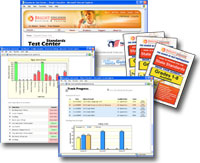About the Missouri Assessment Program (MAP)What is the Missouri Assessment Program (MAP)?State Testing Information for Missouri Portions of the following material were taken from the Missouri Department of Education website. Please see our links and source sections at the bottom of the page for more details and references. General Description of the Tests Missouri Assessment Program (MAP)
- Improving students’ acquisition of important knowledge, skills, and competencies - Monitoring the performance of Missouri’s educational system - Empowering students and their families to improve their educational prospects - Supporting the teaching and learning process MAP-Alternate (MAP-A)
National Assessment of Educational Progress (NAEP)
Practice Tests for the Missouri Assessment Program (MAP)
Our curriculum is focused around actual material that a student is
likely to see on the upcoming Missouri Assessment Program (MAP) test. Nationally known for delivering high
quality and affordable materials that help students improve their scores,
we provide you both paper-based instruction and easy to use online test
preparation.
|
||
More About the Missouri Assessment Program (MAP) Tests
Test Descriptions Missouri Assessment Program (MAP)
- speaking and writing Standard English (including grammar, usage, punctuation, spelling, capitalization) - reading and evaluating fiction, poetry, and drama - reading and evaluating nonfiction works and material (such as biographies, newspapers, technical manuals) - writing formally (such as reports, narratives, essays) and informally (such as outlines, notes) - comprehending and evaluating the content and artistic aspects of oral and visual presentations (such as storytelling, debates, lectures, multi-media productions) - participating in formal and informal presentations and discussions of issues and ideas - identifying and evaluating relationships between language and culture - Number and Operations - addition, subtraction, multiplication, and division; estimation and computing techniques; number representations, systems, and relationships; use of these operations and concepts in the workplace and other situations - Algebraic Relationships - algebraic concepts including patterns, relations, and functions; represent and analyze mathematical structures using algebraic symbols; understand quantitative relationships; analyze change in various contexts - Geometric and Spatial Relationships - geometric and spatial sense including analysis of characteristics/properties of geometric shapes; arguments about geometric relationships; coordinate geometry; symmetry and transformations; visualization, spatial reasoning, and geometric modeling - Measurement - measurable attributes of objects and the units, systems, and processes of measurement; use of appropriate techniques, tools, and formulas to determine measurements - Data and Probability - data collection and statistical reasoning; formulating questions to be addressed with data analysis and statistics; develop and evaluate inferences based on data; understand and apply probability concepts - properties and principles of matter and energy - properties and principles of force and motion - characteristics and interactions of living organisms - changes in ecosystems and interactions of organisms with their environments - processes and interactions of the earth’s systems (geosphere, atmosphere, and hydrosphere) - composition and structure of the universe and the motion of the objects within it - scientific inquiry - impact of science, technology and human activity - National Percentiles (NPs) are determined from a subset of items within the Communication Arts, Mathematics, and Science tests. 2017 - 2018 Testing Schedule
Links
|

